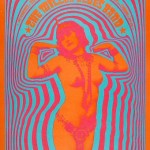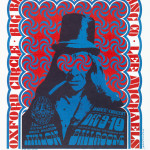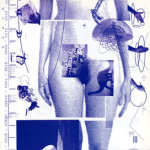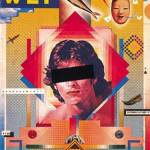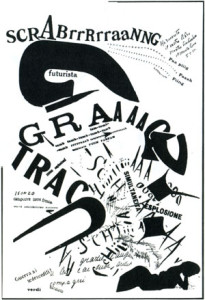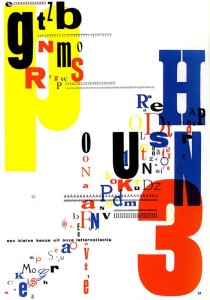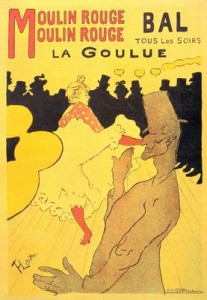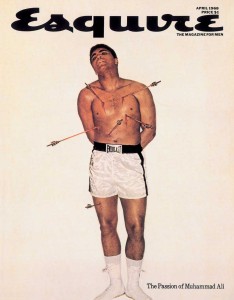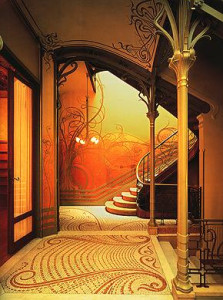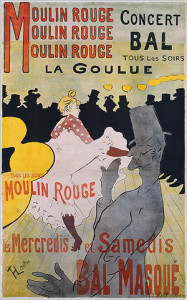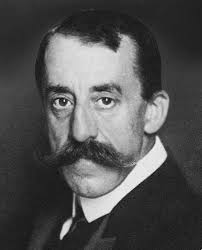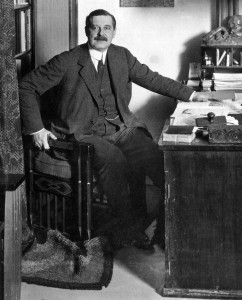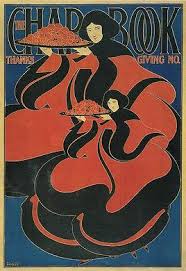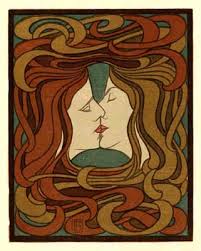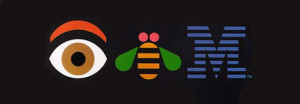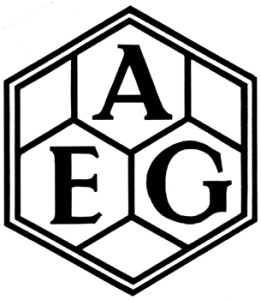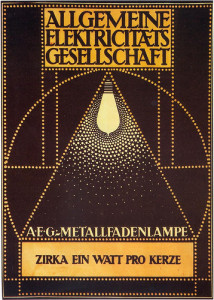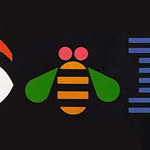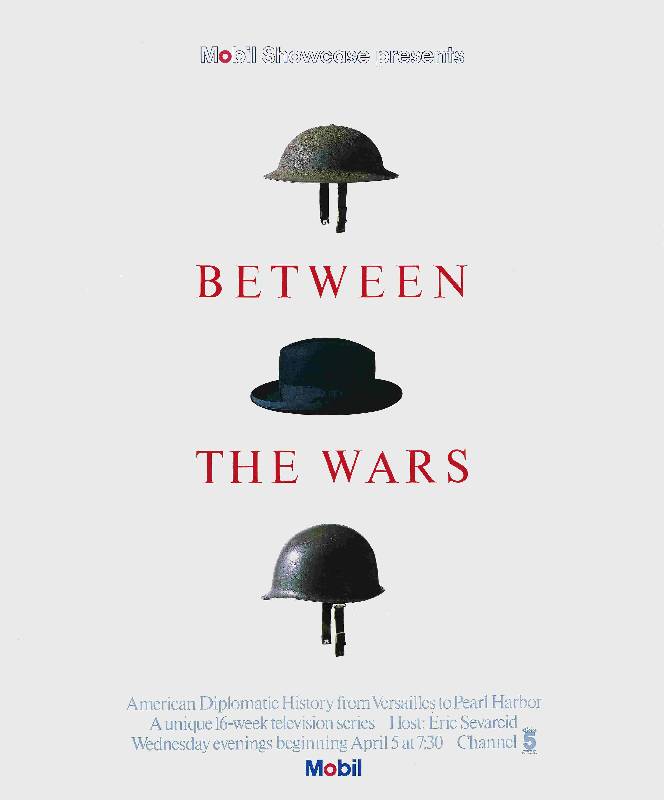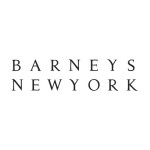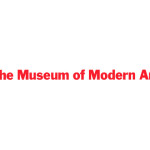From Design Comparison
Design Comparison
Moulin Rouge, Henri de Toulouse-Lautrec (1891)
Henri de Toulouse-Lautrec (1864-1901) was a French painter, printmaker and illustrator. As an artist he made many strides in the Art Nouveau movement. The “Moulin Rouge” piece stood out to me the most out of his work, because of it’s sharp figures and strong use of color.Throughout his life Lautrec traveled through France depicting the nightlife of mostly Paris. Lautrec’s most influential medium was in his commercial advertising, and events in theatre. Some of the movement’s pieces were influenced by Japanese art forms and woodblock prints. Lautrec was influenced by the japanese woodblock, creating contrast with sharp lines and even exploring new forms of typography that was fairly new for the time. He furthered the possibilities of poster arts through his use of color and typography. The fun vibrant setting shown through the people dancing is used to spark the audience’s attention, which is does for me.
Dylan, Milton Glaser (1966)
Milton Glaser (1929-Present) is an American graphic designer who was responsible for creating the I <3 New York Logo and many other logo pieces but for my comparison I am more interested in his advertisement for Bob Dylan. In this piece “which became an icon for the 1960’s experience, brought psychedelic language to mainstream America” (Guide to Graphic Design, 64). Through the piece he created a state of mind, with just the color and line. “The contrast of vivid colors with the dark silhouetted profile reflects Glaser’s response to the Modernist “Less is more” dictum: “Just enough is more.” (Smithsonian, Sign of the Times, Edwards, 1)
The rise of rock ’n’ roll in the 1960s, generated a particular genre of poster art similar to the rise of poster artwork in the Art Nouveau era of the early 19th Century. Henri de Toulouse-Lautrec and Milton Glaser works share a similar style in color and emphasis on the figure. Glaser said he “was interested in Art Nouveau at the time”. “That was an influence for the colors and shapes in the picture.” Glaser’s piece depicting Bob Dylan with kaleidoscopic hair, has been described as “psychedelic” and is often associated with rock posters. Lautrec’s most influential medium was in his commercial advertising, promoting scenes and events in theatre within the arts much like Glaser’s promotion for Dylan.
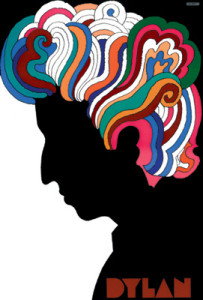 Dylan, Milton Glaser, 1966
Dylan, Milton Glaser, 1966
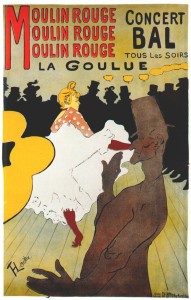 Moulin Rouge, Henri de Toulouse-Lautrec (1891)
Moulin Rouge, Henri de Toulouse-Lautrec (1891)
Design Comparison
Victor Moscoso (1936)
During the 1960s and 1970s, residing in San Francisco but from Spain, Victor created psychedelic rock posters and advertisements with relation to the Underground Comix. Along with billboards, t-shirts and many other materials, his psychedelic designs and styles full of vibrant colors and hypnotizing creations were influenced by the artist Josef Albers; one of his teachers from Yale, Albers was the first of the rock poster artists to use photographic collage on a majority of his posters. Moscoso received international consideration from his work and created many album covers for musicians including Herbie Hancock, Jerry Garcia and other known artists of the era.
April Greiman (1948)
During the late 1970s and early 1980s, Greiman was one of the first designers to to hold of computer technology to use it as a design tool. Those who thought that computer technology and digitalization would harm the design world were proved wrong by the work that Greiman created from it. She utilizes color, image and words to express her voice through her pieces.
Both artists used their creative abilities to create a new form of design. Moscoso with the unique psychedelic posters for local musicians and Greiman with her innovative use of the new computer technology to create works of voice and style.
Design Comparison
Filippo Marinetti and Piet Zwart were both innovators at the style of design that they worked in. As for Piet Zwart(1885-1977) he was a pioneer of modern typography. Although Zwart was formally trained as an architect and photographer at the School of Applied Arts in Amsterdam in 1902, he later began to experiment with different typography methods such as bold lines, mixing upper and lower case letters, etc. He did not adhere to traditional typography rules, but used the basic principles of constructivism and “De Stijl”( abstract, economical style. It was influential on the Bauhaus and constructivist movements.) in his commercial work. His work can be recognized by its primary colors, geometrical shapes, repeated word patterns and an early use of photomontage.
Like Zwart, Filippo Marinetti(1876-1944) found design later in his life as he was originally a poet editor. Marinetti was also an innovator of a style of design which is called the futurist movement. Futurism was introduced when Marinetti published an article of Futurism in a Paris newspaper. Marinetti’s stirring words established futurism as a revolutionary movement in which all the arts were to test their ideas and forms against the new realities of scientific and industrial society.
The first piece on the left-hand side is titled “SCRABrrRrraaNNG” by Filippo Marinetti, 1919. Compared to “Trio-Reclameboek” by Piet Zwart, 1931. From taking a glance at both images you can see the physical resemblance that they both share. Both pieces use multiple fonts, both use bold and thin lines, and they both seem as though they are hiding some kind of message to tell to the viewer. Both of these pieces seem as though they are breaking the rules of the design norm for their period. I also found it interesting how both designers found graphic design later in their lives and how they were both founders of their own style.
Henri de Toulouse-Lautrec vs. George Lois
Henri de Toulouse-Lautrec (1864-1901) was a French painter, printmaker and illustrator. As and artist he made many strides in the Art Nouveau movement. Throughout his short life Toulouse-Lautrec traveled depicting the fresh nightlife of Paris. Filled with many artists and students Henri had a vast amount of inspiration in Paris. Lautrec’s most influential medium was in his commercial printing, promoting scenes and events in theatre. Art Nouveau was heavily influenced by Japanese art forms and woodblock prints. Lautrec also took influence from these woodblocks in many of his posters. Creating contrast with sharp lines and even exploring typography that was fairly new for the time. Lautrec even slipped in subtle cultural happenings in his posters. For example in his poster “La Goulue” (below) the woman in a happy public setting is expressing discomfort hinting to the feminism movement that was then hitting Europe. Lautrec personally furthered the possibilities of poster arts to have a social and political voice.
Fast forward to 1931 George Lois is born. During his life he was involved in advertising design and the New York School era of design. This is where images, text and type collided together. This type of design brought a new meaning to advertising. Repeatedly putting text with associated pictures, creating continuous campaigns that became very popular. Typograms also steamed for this age of design. George Lois became the art director of Esquire magazine. Lois would go on to create countless influential covers and other pieces of design for the magazine and other companies. One of the most Iconic is the front cover of the April 1968 issue of Esquire Magazine depicting Muhammad Ali shot with arrows. This cover drawing readers in to a very controversial story involving many social issues at the time race, segregation, religion, draft laws and the most talked about man in professional sports.
I chose to compare these two images because even with a large gap in time and leaps of advancement in technology they are portraying in very similar ways with similar concepts. Both a scene of a person followed by text.
“La Goulue” by Lautrec is very simplistic in terms of technology projecting a scene of dancing in France. At first glance it seems as if it’s just that, but with further analysis you begin to see the social undertones. A very joyful dance floor with the only detailed person being an unhappy woman, in a time of progression of women’s freedoms and feminist advancements. This woman stands alone and she comes along with a subtle yet interesting message leaving you curious. This was the beginning of mediums such as this carry a voicing message.
I compared it to the Esquire cover because I feel as if the “La Goulue” poster paved the way for more evocative covers such as the Muhammad Ali Esquire to come. This cover by Lois and photographer Carl Fischer cannot be ignored. The most controversial man in sports is standing alone in front of you bleeding from multiple arrows sticking out of him. He is in a position similar to the one of Jesus Christ on the cross. This screams a thousand times louder than Lautrec’s message but the end result is similar. It leaves you wondering why this African American Gold medal boxer is being shot with arrows. Lois leaves Muhammad the main focus of the page seemingly tacked to page. The magazine title left behind him leading you to more information. You start to ask yourself is it about race, his change to a controversial religion, or is it about his battles to avoid the draft.
The 77 years that separate these two covers or posters shows the change in technology of printing and freedoms of press. The messages are very different in volume but without Lautrec’s poster with a subtle message you don’t have Lois’s screaming cover. Both of these designs show text with an image and most importantly a message that came on a widely available piece of press.
Henri de Toulouse-Lautrec “La Goulue” 1891
George Lois Art Director And Carl Fischer Photographer Esquire Magazine April 1968
Design Comparison
Victor Horta (1861-1947) was a Belgian architect. Victor began studying architecture at the Académie des Beaux-Arts. He went to Paris from 1887 to 1880 and worked in the studio of the interior decorator Jules Debuyson.
Henri de Toulouse-Lautrec (1864-1901) was a French artist. He is heard along with artist such as Van Gogh as one of the most famous artists during the Post-Impressionism period.
Victor used the Art Nouveau which was a style developed in Europe and North America at the end of the 19th century it was a style of natural forms that were translated into high contrast shapes and patterns. They were very appealing and reflected traditions on history and the classics. In his architectural work he had the stairway in the Tassel House as his main focus. The spacial movement created an organic flow to both the exterior and interior.
Henri also used the Art Nouveau and his became the most expression pieces. Commercial printing was when graphics and color could be combined and reproduced with losing its quality. In his piece called La Goulue he uses flat color and line but the way he works it, it creates a strong visual impact by having the solid black crowd and the dancer against each other. By doing what he did with the simple colors and line he causes the paper to become a part of the drawing. Here you also see typography and it flows nicely with the images like the way he put moulin rouge, rather than just being put on the page.
These two images struck out to me the most while reading through the chapter. Both are from the time period of the Art Nouveau. Also both have sort of like a hidden blend of images in them that make them very famous. The stairway has the natural organic vine like that flows all around, which I find absolutely gorgeous. In the print the use of the solid black crowd creates a spacial distance and makes the dancer stand out showing that she is the importance in the print. With these similar comparisons i found it interesting because just looking at them you would never think that these works would be similar.
Design Comparison Post
In the class text there were two designers that caught my eye.
Henry Van De Velde (April 3, 1863- October 15, 1957)
Henry Van De Velde was born in Amtwerp, Belgium on April 3, 1863. He was a painter, Architect, and an Interior designer. He is one of the main founders and representatives of Art Nouveau in Belgium. He spent a lot of time in Germany and influenced a lot of the architect and design in the 20th century. In the beginning he was actually a painter but in 1892 he devoted his time to interior design. Van de Velde was strongly influence by John Ruskin and William Morris’ English arts and crafts movement. Henry Van De Velde was one of the first designers to incorporate curved lines with the abstract style. In 1899, He settled in Weimer, Germany. By 1905 Henry Van de Velde had established the Grand-Ducal School of Arts and Crafts with the help of the Grand Duke of Weimer. During World War 1 due to being a foreigner, he had to leave Germany and go back to his native lands. He lived in both Switzerland and the Netherlands for some time. He died at age 93 in Zurich.
Peter Behrens (April 14, 1868- February 1940)
Peter Behrens is a german architect and designer. He was very important in the modern movement. From September 1877 to 1882 Behrens attended the christianeum Hamburg. In 1890 he married Lily Kramer and moved to Munich. At first, he worked as a painter, illustrator, and book binder. He was very interested in subjects related to the reform of life-styles. In 1899 Behrens accepted the invitation of the Grand Duke Ernst-Ludwig of Hesse to be the second member of his recently inaugurated Darmstadt Artists’ Colony. Here he built his own house and fully conceived everything inside (furniture, paintings, towels, pottery, etc.). It is said that this was a turning point in his life when moved away and wanted to change to a more unadorned style. He then became one of the leaders of architectural reform during the turn of the century and was a designer of factories, and office buildings in glass, brick, and steel (example: Aeg Turbine hall). While in Berlin (1936) Adolf Hitler wanted Behrens to be apart of his dream for Berlin to get new headquarters but was rejected by Alfred Rosenberg. Hilter really admired his Saint Petersburg Embassy. Four years later Behrens died in Hotel Bristol in Berlin.
Compare
I chose these two pieces because they really stood out to me. The fluidity that they both possess does a great job in capturing the attention of its audience. They relate to each other because they have more of a geometric vibe. A lot of thought was put into where every single line should be placed and the location/curve of the line. Even though these two pieces of art have very different meanings they both still have some physical similarity.
Design Comparisons
Paul Rand
Paul Rand is an American designer who is most noted for his logo design. Some of his most recognized logo designs are ABC, IBM, UPS, and many others. Some of Rand’s most famous work was for the magazine covers of Direction magazine, Rand did these designs for no fee granted he could have full artistic freedom. Another designer who I found interesting was Peter Behrens, who was a German architect and designer. I’m going to be comparing one of Behrens pieces to Rand’s IBM poster.
Peter Behrens
Behrens, who was a German Architect and Designer was very important to the modernist movement, which is essentially the dynamic expression of abstract form, while being used for practical manners. Behrens is responsible for designing AEG from the ground up, this is also known as brand identity. He designed their logo, packaging, and everything else in between.
The piece from Behrens that I am going to be comparing with Rand’s IBM poster is Behrens poster for AEG electric lamps, and is pictured below.
These two pieces are comparable because they are examples of historic pieces of Graphic Design from the 1900’s. It is interesting because they are both marketing tools for two different corporations which the designers worked for. Rand worked for IBM while Behrens worked for AEG. Rand’s poster is an example of design being simple, yet effective. The poster uses symbols for each letter and is a creative solution to the design problem. Behrens poster is a poster for electric lamps that uses circles repetitively around the focal point (the lightbulb) and the typography up top. The poster uses three different colors, all of which work well together. In my opinion Rand’s poster is a stronger design because of the color theory, and simplicity.
Design Comparison
Paul Rand (1914-1996)
Paul Rand was considered to be one of the most influential American graphic designers of his time, and looking at his work I can see why. He designed many posters and corporate identities, including the logos for IBM, UPS and ABC. Rand studied at the Pratt Institute from 1929 to 1932, and the Art Students League from 1933 to 1934. He taught design at Yale from 1956 to 1969, and beginning again in 1974. He was interested in Modernism and logo designs which is what he did with his career. I really like his logo designs, because he helps prove that great works wont go out of style.
Ivan Chermayeff (b. 1932)
I really like Ivan Chermayeff’s poster Between the Wars because it is a very simple way to convey a huge message. Once I started looking into his work, I realized that he has created a vast majority of logos that are still popular today. He has created logos for Showtime, NBC, The Museum of Modern Art and many more. Chermayeff studied at Harvard University, the Institute of Design in Chicago, and graduated from Yale University, School of Art and Architecture. In 1956, Chermayeff and Tom Geismar began their firm Chermayeff & Geismar & Haviv and they are still designing today, almost 60 years later. Chermayeff was interested in Advertising Design, and almost all of his works have been advertisements, or logos for companies.
Paul Rand and Ivan Chermayeff are very similar in the fact that they are both graphic designers that focus on logos, but have both branched out and done books as well as posters. Rand was Chermayeff’s teacher at Yale and he then became one of Chermayeff’s biggest inspirations. Chermayeff mentions that not only was Rand an inspiration, they were good friends. I think that Chermayeff’s work reflects the simplicity and timeless effect of Rand’s work.
Design Comparison
Henri de Toulouse-Lautrec VS Paula Scher
Henri de Toulouse-Lautrec was a French artist, born in 1864. La Goulue, made in 1891, came from the inspiration of Japanese woodcuts. This influence helped Lautrec create a visually impacting poster with the use of flat color and line. The repeating “Moulin Rouge” stood out to me the most in La Goulue. After reading more about it, I learned that the reason why the words are tripled is to create a bouncing effect, to mimic the rhythm of the dancing hall being portrayed. The letters throughout the entire poster are capitalized, but the rounded edges of the font create an inviting look to the poster. The joyous setting being shown through the dancing people is used to spark the audience interest into attending.
Paula Scher’s, born in 1948, uses New York City as an influence to create energetic and bold designs. The pentagram shown below is a seasonal campaign poster made for The Public Theater. She uses typography to her advantage to emphasize entertainment and excitement. Much like Lautrec, she uses flat color and lines to create a visually impacting poster. Scher placed words in a funky way by angling their baselines to express more emotion. We see the same qualities in La Goulue with the use of repetition in words. Ironically enough, both posters use the same four colors: red, yellow, black, and white. All of these aspects create a very inviting look for the two posters, which was the goal for both artists.


La Goulue by Henri de Toulouse-Lautrec | The Public Theater by Paula Scher
